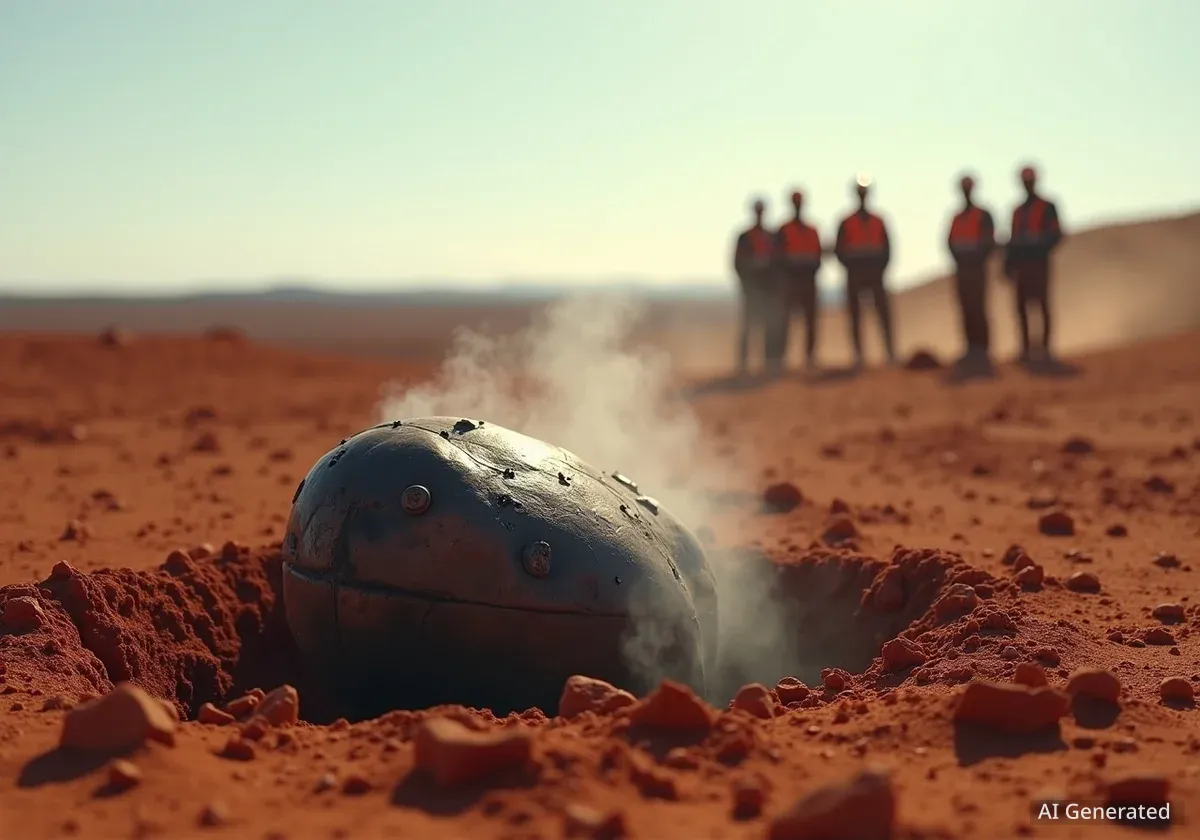A large, charred object believed to be space debris was discovered by mine workers on a remote desert road in Western Australia this past Saturday. The Australian Space Agency has since stated the object is likely a component from a space launch vehicle, bringing renewed attention to the growing issue of orbital pollution falling back to Earth.
Photos from the scene showed the object was still smoking when found, highlighting a dramatic and unexpected arrival. Authorities are now working to confirm its exact origin, with experts pointing to a possible link with a recent rocket launch.
Key Takeaways
- A significant piece of suspected space junk was found on a road in Western Australia over the weekend.
- The Australian Space Agency believes it is a propellant tank or pressure vessel from a rocket.
- Experts speculate the debris may be from the upper stage of a Chinese Jielong rocket.
- The incident is part of a growing trend of space hardware surviving re-entry and reaching the ground.
Discovery in the Outback
The unusual discovery was made by a group of mine workers traveling along a remote access road. They encountered the large, cylindrical object lying in the middle of their path. According to the Western Australia Police Force, who were called to the scene, parts of the debris were still burning, with smoke visible in the air.
Initial assessments by police suggest the object is constructed from carbon fiber. This material is consistent with modern aerospace manufacturing, particularly for components like composite-overwrapped pressure vessels or rocket fuel tanks designed to be lightweight yet strong.
Authorities secured the area to ensure public safety while awaiting analysis from space experts. The exact dimensions and weight of the object have not yet been publicly released, but images suggest it is a substantial piece of hardware.
Tracing the Debris's Origin
The Australian Space Agency officially commented on the finding, confirming its likely man-made, extraterrestrial origin. In a statement, the agency noted, “The debris is likely a propellant tank or pressure vessel from a space launch vehicle.”
While the agency's investigation is ongoing, independent experts have already begun to speculate on its source. Dr. Alice Gorman, a space archaeologist at Flinders University, suggested a connection to a Chinese rocket.
“The last launch was late September, so this has been barreling around the Earth and quite suddenly has got pulled back to the atmosphere,” Dr. Gorman explained in a radio interview.
She also pointed out a compelling pattern. “A month ago, similar pieces were discovered in Argentina,” she added. “These pieces were coming from the Jielong rocket body. The [rocket’s] trajectory covers Australia and they are very, very similar pieces.”
A Global Pattern
The discovery in Australia follows a similar incident in Argentina just one month prior, where debris also believed to be from a Jielong rocket was found. This suggests a potential pattern of debris from specific launch vehicles surviving re-entry over certain trajectories.
A Sky Crowded with Junk
This incident is not an isolated curiosity; it is a symptom of an increasingly crowded orbital environment. The modern space race, driven by both national agencies and private companies like SpaceX, has led to an unprecedented number of launches. Elon Musk’s Starlink constellation alone consists of thousands of satellites.
This surge in activity has a direct consequence: more objects eventually fall out of orbit. It is now estimated that at least one defunct satellite or piece of rocket debris re-enters Earth's atmosphere every single day.
Most of these objects are small and are designed to completely disintegrate from the intense heat of re-entry. However, as recent events show, larger and more durable components are increasingly surviving the journey to the ground.
Recent Space Debris Incidents
- Florida, 2023: A 1.6-pound metal object from a discarded International Space Station battery pallet crashed through the roof of a family's home.
- Canada, 2023: A chunk of a SpaceX Crew Dragon capsule, weighing nearly 100 pounds, landed on a farmer's property in Saskatchewan.
- Australia, 2022: A ten-foot shard from the trunk of a SpaceX Dragon capsule was discovered on a sheep farm in New South Wales.
The Challenge of Modern Materials
One of the key questions facing the space industry is why these large pieces are surviving their fiery descent. A contributing factor may be the very materials that make modern spaceflight possible.
Spacecraft today are often built with advanced composite materials, like the carbon fiber identified in the Australian debris. These materials are much lighter than the titanium and aluminum alloys that dominated the early Space Age. While their lightness is an advantage for launches, their behavior during the extreme conditions of atmospheric re-entry is not as well-documented.
As more objects made from these newer materials begin to fall back to Earth, experts are realizing that our understanding of how they break apart—or fail to—may be incomplete. This unpredictability poses a growing risk, turning the vast, open skies into a potential source of danger for those on the ground.




